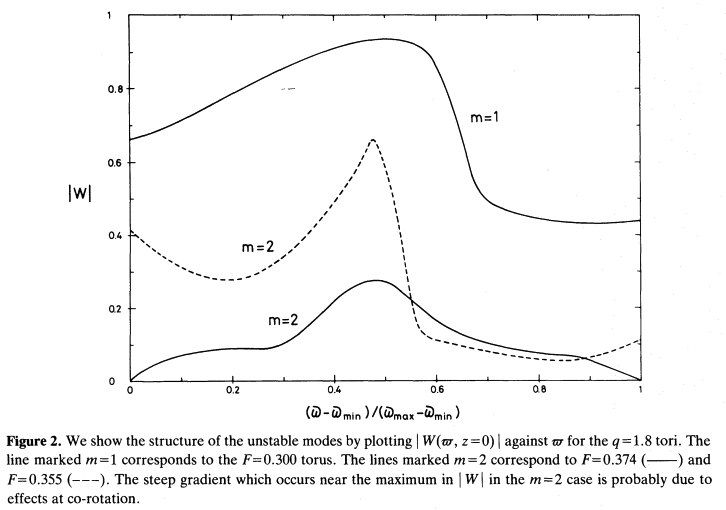User:Tohline/Appendix/Ramblings/PPTori
Stability Analyses of PP Tori

|
|---|
| | Tiled Menu | Tables of Content | Banner Video | Tohline Home Page | |
As has been summarized in an accompanying chapter — also see our related detailed notes — we have been trying to understand why unstable nonaxisymmetric eigenvectors have the shapes that they do in rotating toroidal configurations. For any azimuthal mode, <math>~m</math>, we are referring both to the radial dependence of the distortion amplitude, <math>~f_m(\varpi)</math>, and the radial dependence of the phase function, <math>~\phi_m(\varpi)</math> — the latter is what the Imamura and Hadley collaboration refer to as a "constant phase locus." Some old videos showing the development over time of various self-gravitating "constant phase loci" can be found here; these videos supplement the published work of Woodward, Tohline & Hachisu (1994).
Here, we focus specifically on instabilities that arise in so-called (non-self-gravitating) Papaloizou-Pringle tori and will draw heavily from two publications: (1) Papaloizou & Pringle (1987), MNRAS, 225, 267 — The dynamical stability of differentially rotating discs. III. — hereafter, PPIII — and (2) Blaes (1985), MNRAS, 216, 553 — Oscillations of slender tori.
PP III
|
Figure 2 extracted without modification from p. 274 of J. C. B. Papaloizou & J. E. Pringle (1987)
"The Dynamical Stability of Differentially Rotating Discs. III"
MNRAS, vol. 225, pp. 267-283 © The Royal Astronomical Society |
Blaes85
His Notation
Blaes (1985) adopts a polytropic equation of state,
<math>~\frac{\rho}{\rho_c} = \Theta_H^n \, ,</math>
which gives rise to (slim tori) equilibrium structures for which (see his equation 1.3),
|
<math>~\Theta_H</math> |
<math>~=</math> |
<math>~1 - \frac{1}{\beta^2}\biggl[x^2 + x^3(3\cos\theta - \cos^3\theta) + \mathcal{O}(x^4) \biggr] \, ,</math> |
where, the (constant) model parameter,
<math>\beta \equiv \frac{(2n)^{1/2}}{\mathcal{M}_0} \, ,</math>
and <math>~\mathcal{M}_0</math> is the Mach number of the rotational velocity at the torus center. Blaes then adopts a related parameter that is constant on isobaric surfaces, namely,
<math>\eta^2 \equiv 1 - \Theta_H \, ,</math>
which is unity at the surface of the torus and which goes to zero at the cross-sectional center of the torus. Notice that <math>~\eta</math> tracks the "radial" coordinate that measures the distance from the center of the torus; in particular, keeping only the leading-order term in <math>~x</math>, there is a simple linear relationship between <math>~\eta</math> and <math>~x</math>, namely,
|
<math>~\eta</math> |
<math>~=</math> |
<math>~[1 - \Theta_H]^{1/2} \approx \frac{x}{\beta} \, .</math> |
Analytically Prescribed Eigenvector
From my initial focused reading of the analysis presented by Blaes (1985), I conclude that, in the infinitely slender torus case, unstable modes in PP tori exhibit eigenvectors of the form,
|
<math>~\frac{\delta W}{W_0} \equiv \biggl[ \frac{W(\eta,\theta)}{C} - 1 \biggr]e^{im\Omega_p t}e^{-y_2 (\Omega_0 t)} </math> |
<math>~=</math> |
<math>~\biggl\{ f_m(\eta,\theta)e^{-i[m\phi_m(\varpi) + k\theta]} \biggr\} \, ,</math> |
where we have written the perturbation amplitude in a manner that conforms with the notation that we have used in Figure 1 of a related, but more general discussion. As is summarized in §1.3 of Blaes (1985), for "thick" (but, actually, still quite thin) tori, "exactly one exponentially growing mode exists for each value of the azimuthal wavenumber <math>~m</math>," and its complex amplitude takes the following form (see his equation 1.10):
|
<math>~f_m(\eta,\theta)</math> |
<math>~=</math> |
<math> ~\beta^2 m^2 \biggl[ 2\eta^2 \cos^2\theta - \frac{3\eta^2}{4(n+1)} - \frac{(4n+1)}{4(n+1)^2} \pm 4i\biggl(\frac{3}{2n+2}\biggr)^{1/2} \eta\cos\theta\biggr] + \mathcal{O}(\beta^3) \, . </math> |
We should therefore find that the amplitude (modulus) of the enthalpy perturbation is,
|
<math>~\biggl|\frac{\delta W}{W_0} \biggr|</math> |
<math>~=</math> |
<math>~\sqrt{[\mathrm{Re}(f_m)]^2+ [\mathrm{Im}(f_m)]^2} \, ;</math> |
and the associated phase function should be,
|
<math>~m\phi_m + k\theta</math> |
<math>~=</math> |
<math>~\tan^{-1} \biggl\{ \frac{-\mathrm{Re}(f_m)}{\mathrm{Im}(f_m)} \biggr\}</math> |
|
<math>~f_\ln(\varpi)</math> |
<math>~=</math> |
<math>~\tanh^{-1}\biggl[1 - 2 \biggl( \frac{\varpi - r_-}{r_\mathrm{mid}-r_-} \biggr) \biggr]</math> |
for |
<math>r_- < \varpi < r_\mathrm{mid} \, ;</math> |
|
| and | |||||
|
<math>~f_\ln(\varpi)</math> |
<math>~=</math> |
<math>~\tanh^{-1}\biggl[1 - 2 \biggl( \frac{\varpi - r_+}{r_\mathrm{mid}-r_+} \biggr) \biggr]</math> |
for |
<math>r_\mathrm{mid} < \varpi < r_+ \, .</math> |
|
See Also
- Imamura & Hadley collaboration:
- Paper I: K. Hadley & J. N. Imamura (2011, Astrophysics and Space Science, 334, 1-26), "Nonaxisymmetric instabilities in self-gravitating disks. I. Toroids" — In this paper, Hadley & Imamura perform linear stability analyses on fully self-gravitating toroids; that is, there is no central point-like stellar object and, hence, <math>~M_*/M_d = 0.0</math>.
- Paper II: K. Z. Hadley, P. Fernandez, J. N. Imamura, E. Keever, R. Tumblin, & W. Dumas (2014, Astrophysics and Space Science, 353, 191-222), "Nonaxisymmetric instabilities in self-gravitating disks. II. Linear and quasi-linear analyses" — In this paper, the Imamura & Hadley collaboration performs "an extensive study of nonaxisymmetric global instabilities in thick, self-gravitating star-disk systems creating a large catalog of star/disk systems … for star masses of <math>~0.0 \le M_*/M_d \le 10^3</math> and inner to outer edge aspect ratios of <math>~0.1 < r_-/r_+ < 0.75</math>."
- Paper III: K. Z. Hadley, W. Dumas, J. N. Imamura, E. Keever, & R. Tumblin (2015, Astrophysics and Space Science, 359, article id. 10, 23 pp.), "Nonaxisymmetric instabilities in self-gravitating disks. III. Angular momentum transport" — In this paper, the Imamura & Hadley collaboration carries out nonlinear simulations of nonaxisymmetric instabilities found in self-gravitating star/disk systems and compares these results with the linear and quasi-linear modeling results presented in Papers I and II.

|
|---|
|
© 2014 - 2021 by Joel E. Tohline |
